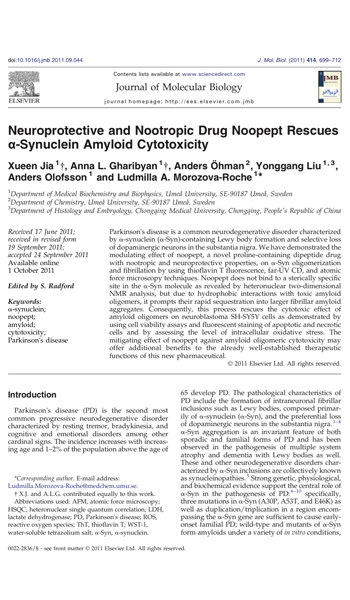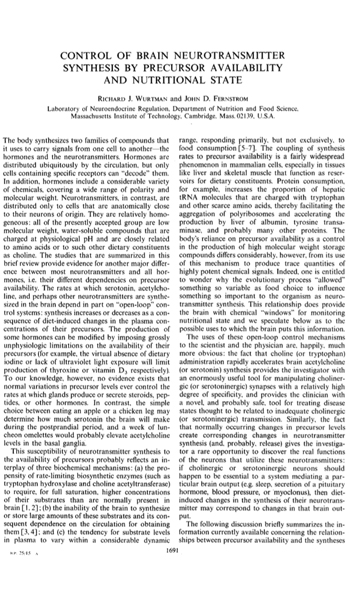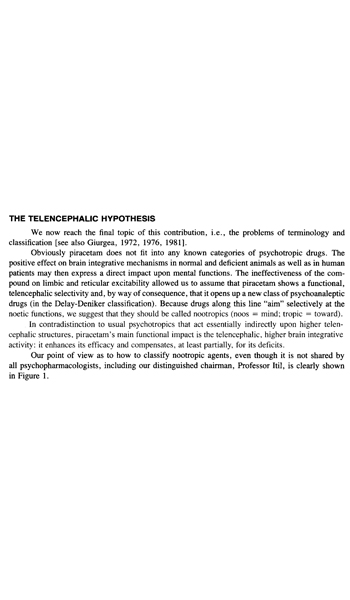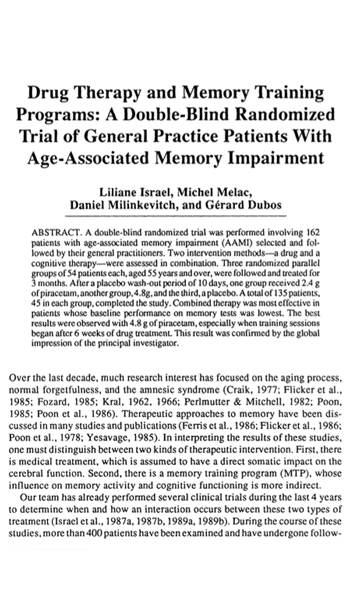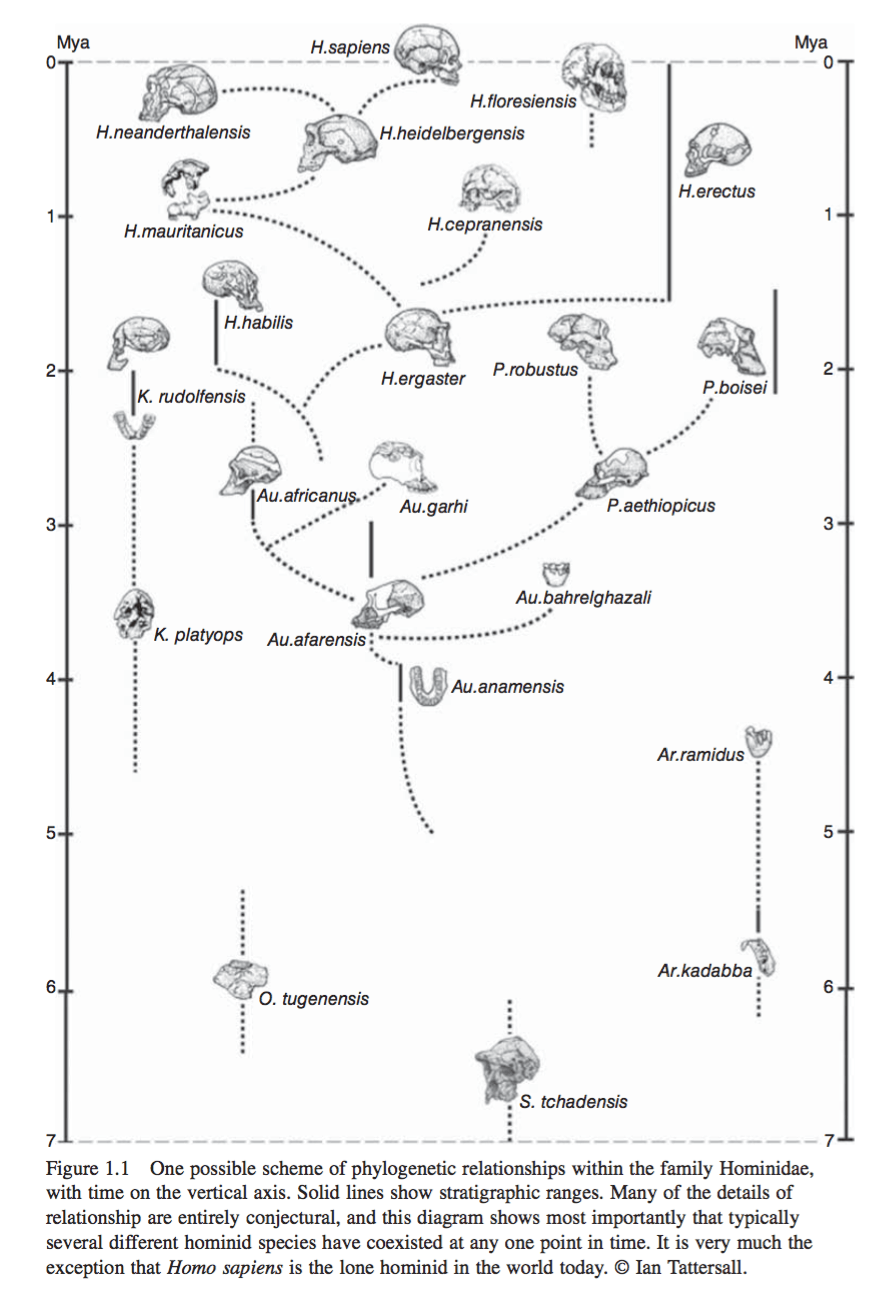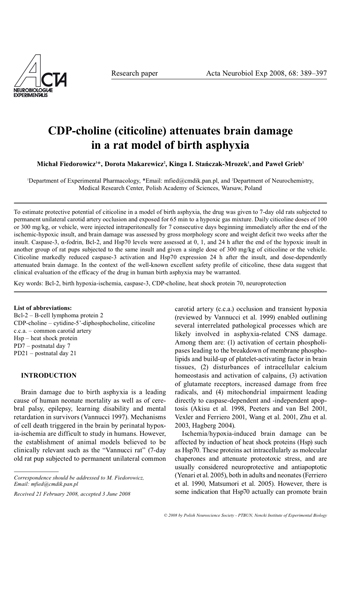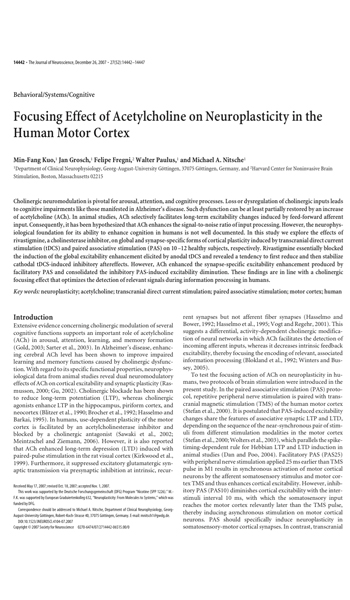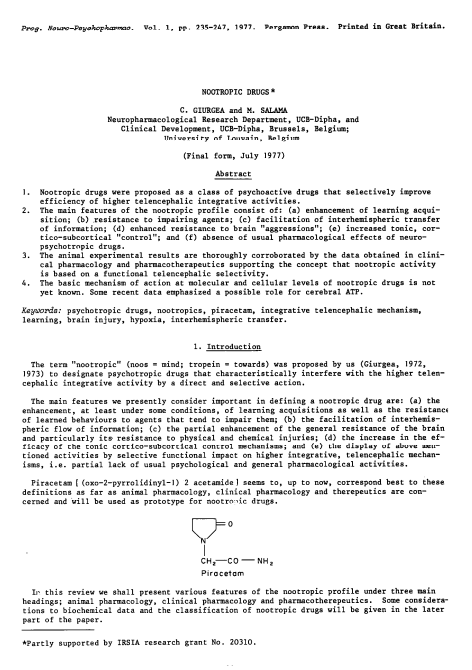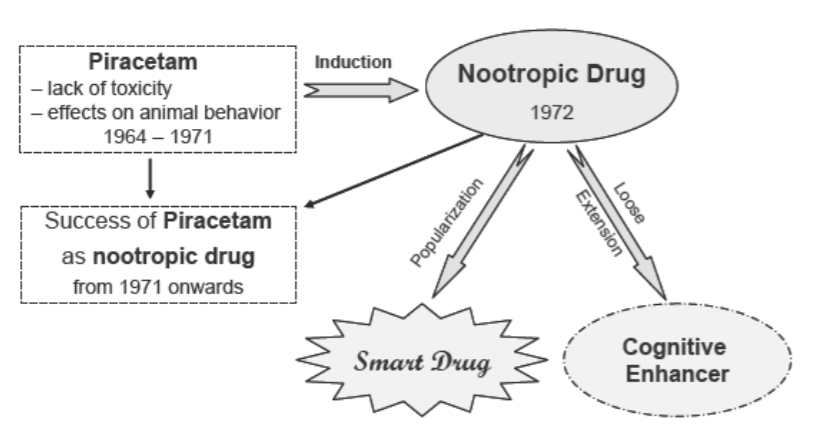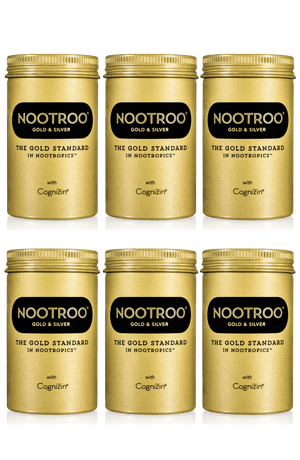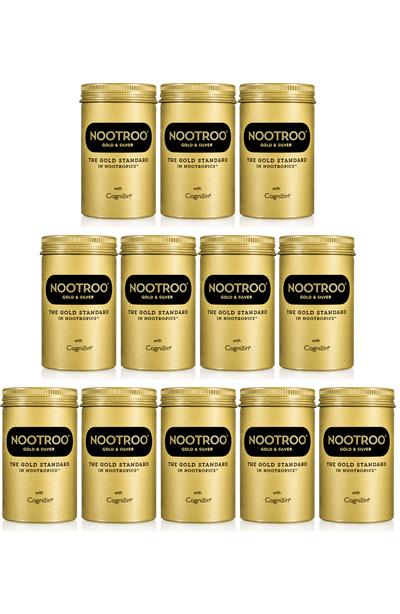”Humanity will not wait millions of years until Mother Nature will hand it a functionally better brain... Humans will directly, openly and consciously take part in evolution.
Corneliu Giurgea (1923-1995)Father of the Nootropic Concept
Nootropics: Towards the Mind
Nootropics are a category of agents that work selectively "towards the mind." Nootropics act directly on the integrative activity of the mind that occurs at the highest levels of the brain (the telencephalon).
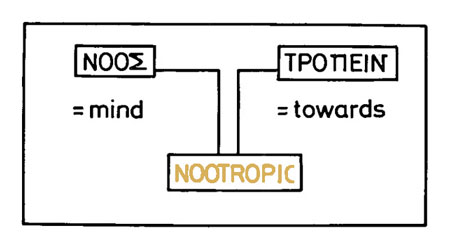
The telencephalon contains sophisticated structures such as the hippocampus (where memory forms), Broca's area (where speech forms), and the corpus callosum (where information crosses hemispheres). Because of this action on the integration of these wide-ranging brain systems, nootropics are able to act on the full processes related to learning, speech, memory acquisition, consolidation, and recall. Their selective action must also occur while being virtually free of side-effects and non-toxic, even at high doses.
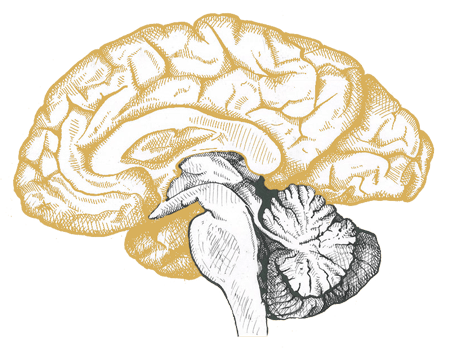
No molecule had ever been found that possessed all of these properties until 1964. While working to develop a sleep-aid, scientists modified the naturally occurring neurotransmitter GABA. What they discovered instead of a sleep-aid was something much more profound, a molecule that would be later be known as piracetam, the prototype of an entirely new class.
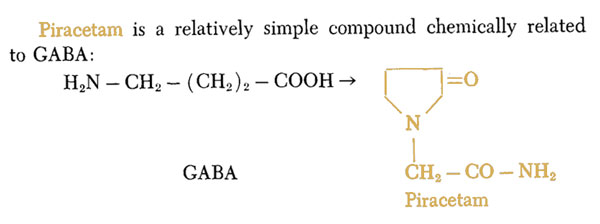
After 9 years investigating and elucidating the properties of this molecule, the lead neuropharmacologist, Corneliu Giugea concluded that in order to categorize it, an entirely new class was required. In 1972, he coined the term nootropics, meaning "towards the mind," for agents that act selectively to enhance the higher-level "integrative activity" of the brain.



Properties of a Nootropic
Based on Giurgea's definition, a nootropic must demonstrate all of the following properties:

Improve learning acquisition and enhance resistance to learning impairments from causes such as lack of oxygen (hypoxia), electroconvulsive shock (ECS), and chemicals that tend to disrupt memory formation (scopolamine).

Facilitate Interhemispheric Transfer & Synchronization
Facilitate the transfer of information from one hemisphere to the other, across the corpus callosum, which increases synchronization between the hemispheres.

Non-Stimulant & Non-Sedative
Work by increasing the integration of higher-level (telencephalic) activity. On over 30 classical pharmacological tests, the original nootropic shows no activity, including as neither a central nervous stimulant nor a sedative.

Enhance Cerebral Resistance
Increase the brain's ability to resist" aggressions" and increase recovery time after loss of oxygen, physical trauma, and more..

Strengthen Control of Subcortical Processes
While not acting on directly the central nervous system, nootropics are still able to modulate cortical tonic control, as seen in central nystagmus and spinal fixation.

Non-Toxic & Low-to-No Side Effects
Must work in harmony with the brain, being virtually free of side-effects and non-toxic even in high doses. Nootropics must not be habit-forming or cause withdrawal.
About Nootroo
Nootroo is a nootropics company founded in 2014 by Eric Matzner and is based in San Francisco's Misson District. Nootroo's tagline is "The Gold Standard In Nootropics™" because of our dedication to creating the best nootropics possible, by using only the purest, most-effective ingredients and never cutting any corners. Our products use no additives, fillers, binding agents or artificial colors, just pure, lab-tested nootropics.
Our Gold and Silver 5.0 Formulas have been developed over 5 iterations and combine the over 50 years of research on nootropics, with cutting-edge advances in neuroscience, and insights from the worlds leading biohackers, to create the best nootropics stacks ever produced.
The Magic Behind Nootroo:
Next-Generation Nootropics
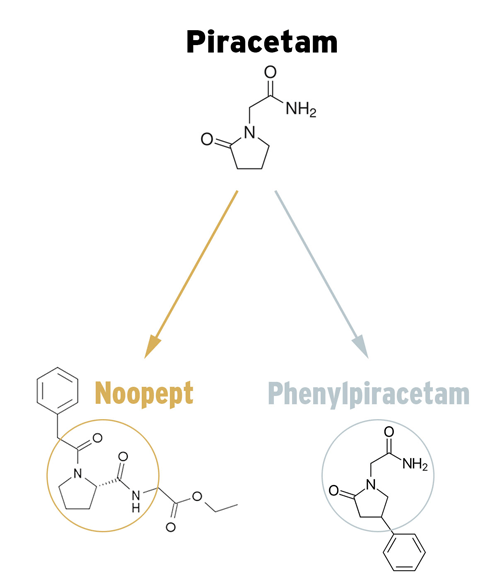
Synergistic Formulations
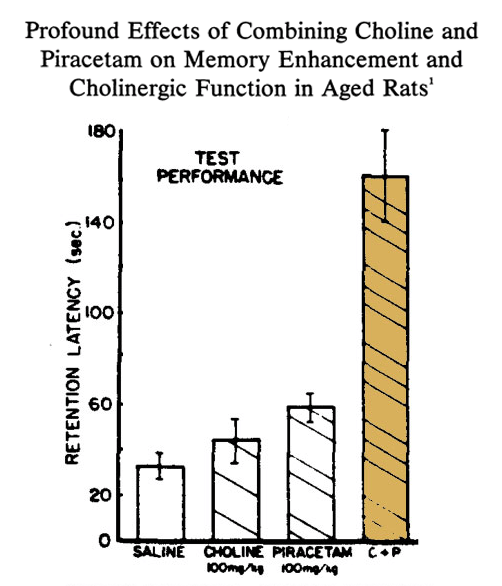
Protocol For Optimal Performance
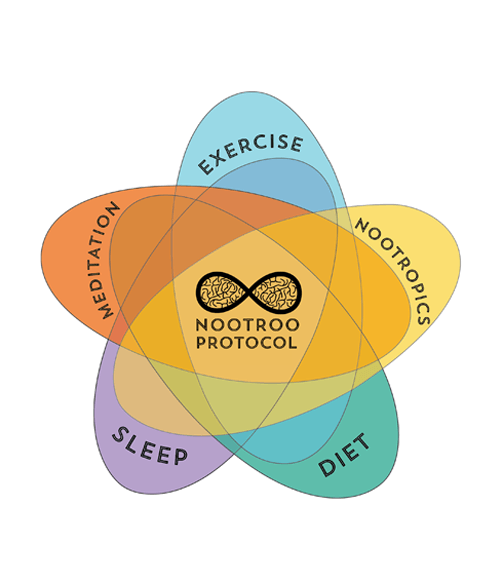
As Featured In:





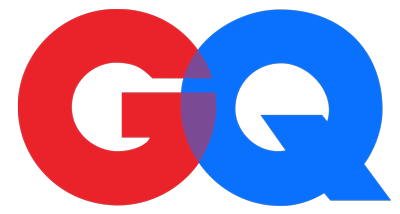






BBC’s Health Episode of “Billion dollar Deals and How They Changed Your World” 3:44
The BBC came to check out what is going on in Silicon Valley with those choosing to enhance their biology and push forward science, to see if they just might end up pushing forward the world.
ABC Nightline News Feature On Nootropics 2:27
Nightline News dropped by to see what all the hype over nootropics is about. They interviewed a Nootroo customer to find “the secret to her work hard play hard lifestyle.”
How to Live Forever: The Morning Routine of a Biohacker 1:38
NPR wanted some tips on how biohacker and Nootroo founder, Eric Matzner, starts his day, so he showed them the Nootroo Protocol.
History of Nootropics
An accidental discovery...
In the early 1960s, scientists were working to develop a form of the neurotransmitter GABA, that would be able to cross the blood-brain barrier and potentially work as a sleep aid.[1]How To Deal With An Unusual Pharmacological Pattern: The Nootropic Case, C Giurgea, P197, 1976.
While they succeeded in developing a molecule with the ability to enter the brain, they failed at creating a sleep aid. What they discovered instead, however, was a molecule that would later prove to be much more profound.
Like a sculptor removing parts of the stone to reveal the beauty within,[2]"Within the marble itself, Michelangelo thought lies the beauty, it is not created by the sculptor. He only takes out the excess of stone and so makes beauty available to our eyes. Scientific … Continue reading Corneliu Giurgea, the lead scientist at the lab, and his team would work diligently to chip away at the unknowns of piracetam, to reveal the properties within it.
After 9 years of research, Giurgea had determined that this molecule (piracetam) acted in such a unique way on the higher-level, integrative activities of the brain, that in order to classify it, the creation of an entirely new classification was required: " the nootropic approach to integrative activity of the mind."
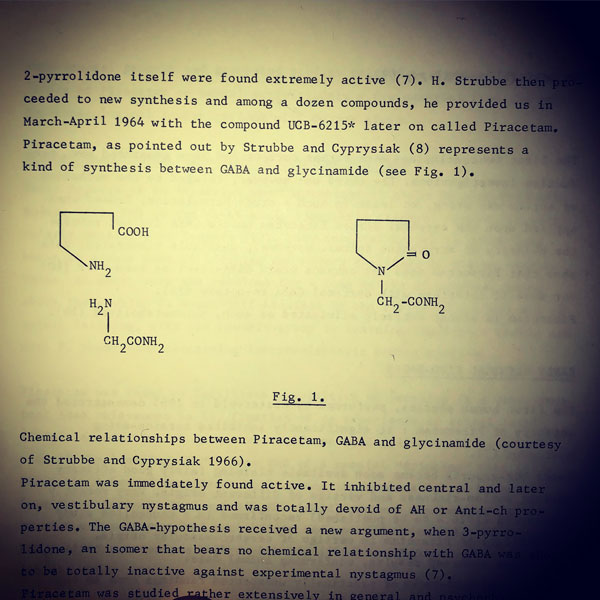
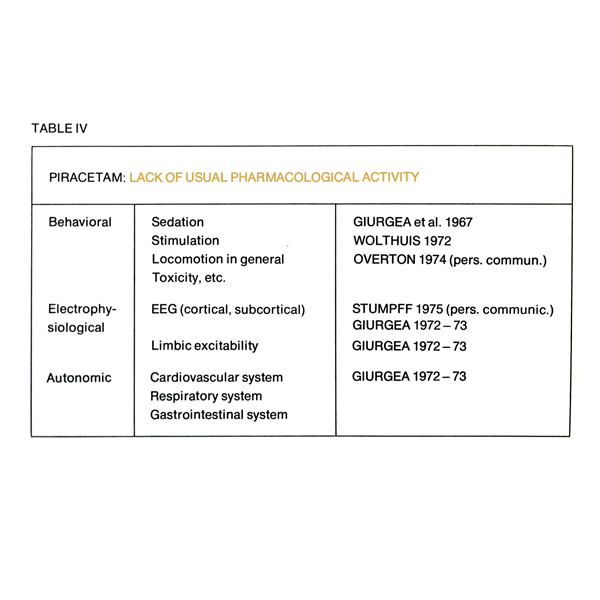
A Challenging Compound
"Lack of Usual Activity"
On over 30 pharmacological tests, Piracetam was found to have no activity, including being neither a sedative nor a stimulant. It also had no toxicity and few side effects, even when given in extremely high doses, such as grams per kilogram of body weight, to mice, rats, cats, dogs, and monkeys with single or multiple doses, even over long-term administration.
In fact, because of those properties, piracetam seemed to be inactive. Had it not been for a test on nystagmus (involuntary eye movements), where they found it immediately active, piracetam likely would have been passed over. This discovery was especially intriguing to the researchers because all of the then-known agents active against nystagmus were either antihistamines or anticholinergics.
It was clear that piracetam did not fit into either of those classes, so the researchers set out to understand which class it did fit into. As they would eventually discover, no existing class embodied the properties of this "unusual" molecule.[3]"Piracetam was such a challenge to our laboratory until we accumulated an important body of knowledge, which made it possible to attempt a relatively comprehensive interpretation of the particular … Continue reading [4]"Piracetam: Nootropic Pharmacology of the Neurointegrative Activity, P229
Unexpected Results
"Memory Seemed Somehow Improved"
The first human trials began in 1965 and showed that piracetam was able to significantly inhibit nystagmus.[5]Giurgea et al 1976 Because there was extremely low toxicity and seemingly few side-effects, they began to test piracetam in other populations. Further data reported internally[6]at their lab, UCB Pharma in Belgium then claimed "fairly good efficacy against motion sickness and vertigo" in humans. These findings lead them to search for a "more comprehensive picture of piracetam from the neurophysiological point of view."[7]Fundamentals to a Pharmacology of the Mind, Giugea 1981
As they were carrying out these follow up studies over 1966-1967, a series of surprising results were reported. First, results came in from a study done at a hospital in Finland on post-concussion patients. The scientists running the study wrote to Giurgea[8]Personal Communications between Giurgea and Prof. Hilboom and Dr. Jahro to let him know that the "patients memory seemed somehow improved, that they declared to 'think' better."[9]How To Deal With An Unusual Pharmacological Pattern ; The Nootropic Case, C Giurgea, P198, 1976.
Then came word from a trial in Brusseles[10]Personal Communications between Giurgea and Prof. Sorel on epileptic children administered piracetam. The parents of the children in the study "claimed a kind of improvement in the overall mental efficiency." And then another researcher[11]Personal Communications between Giurgea and Prof. Ectors in Bruxelles reported to him that his Parkinsonian patients under Piracetam were "somehow more aware of their sickness."
Since Giurgea and his team had previously demonstrated piracetam selectively enhanced interhemispheric communication (see associated image), he had suspected that the compound might facilitate other cortically integrated mental functions, but at that time, he had no idea the extent.
This new information changed the course of their clinical work and they began to focus on "studies related to a potential beneficial effect of Piracetam on mental activity."[12]How to Deal With an Unusual Pharmacological Pattern: The Nootropic Case, Giurgea 1976, P198

Nootropic Properties Revealed
As experimental data on the neurochemical mechanisms of piracetam continued to expand, Giurgea and his team began to zero in on some overarching properties of the molecule that would come to define the nootropic class.
In normal subjects, piracetam appeared to "activate efficiency of higher nervous function" and in the case of injury, piracetam appeared to "protect and/or facilitate restoration of normal brain activity."
From these observations and others, Giurgea surmised that piracetam, and potentially other molecules like it, "appeared to have a selective activity upon the higher-integrative mechanisms of the brain."[13]Fundamentals to a Pharmacology of the Mind, Giurgea 1981 P 192
Enhancement of Learning & Memory

Rats learned how to exit a water maze much more quickly when on piracetam.
Facilitation of Interhemispheric Transfer
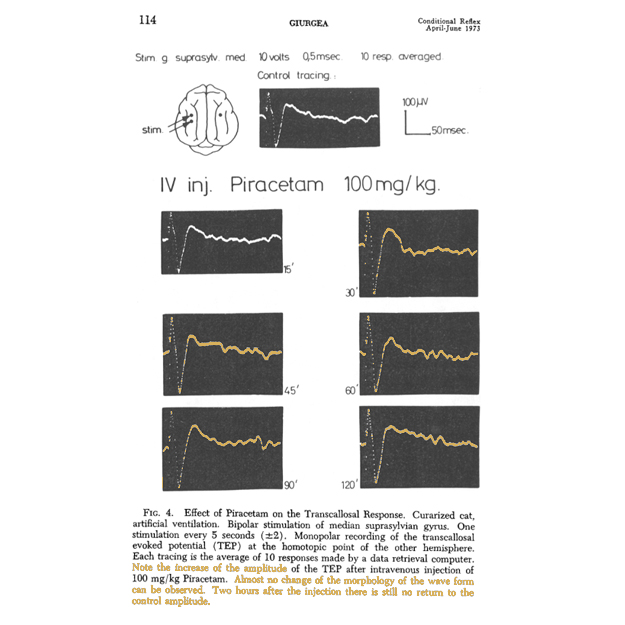
Notice the change in the amplitude of the evoked potential of the corpus callosum, without a change in morphology. Demonstrating telencephalic selectivity.
Protection Against Loss of Oxygen

Memory is protected from disruption during a loss of oxygen (hypoxia) if the rats are given Piracetam prior.
Protection From Electroconvulsive Shock
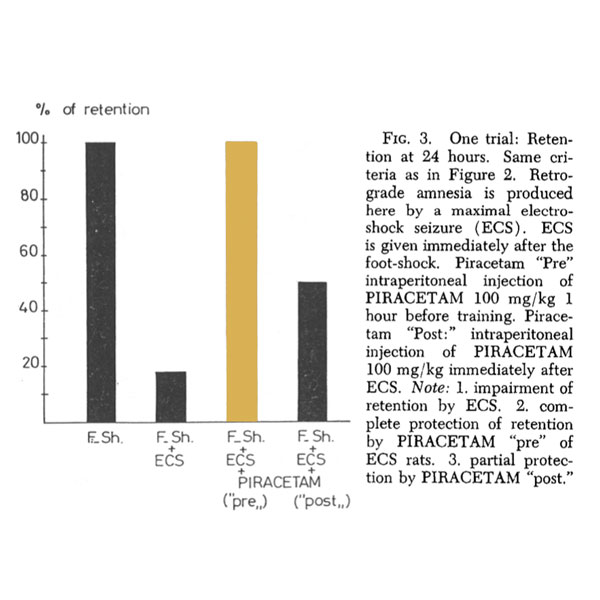
After having their brains electroconvulsively shocked, after 24-hours, rats given piracetam prior remembered 100%, while rats on placebo remembered less than 20% of the time.
Increased Control of Subcortical Processes
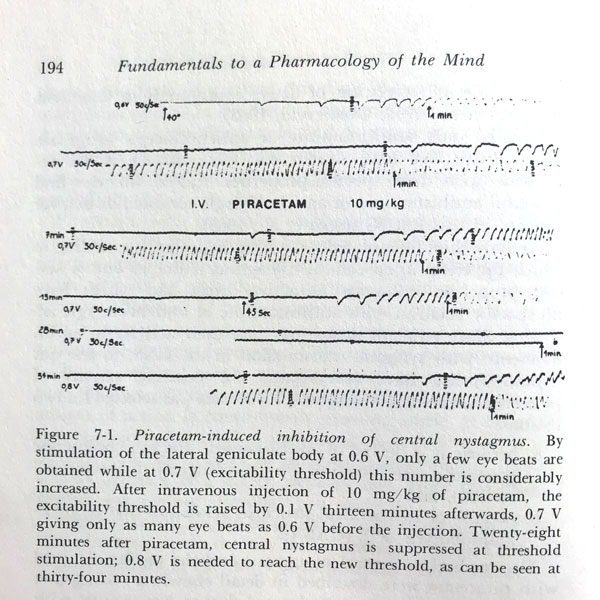
Piracetam suppresses nystagmus at high and low doses and enhances the stimulation threshold.
Inactive on over 30 Pharmacological Tests

No sedation or tranquilization, no stimulation, no interference with synaptical transmitters, no acute or long-term toxicity. No cortical or subcortical EEG changes in reticular sensory or direct arousal threshold, etc. No changes of the cardiovascular, respiratory, gastrointestinal systems.
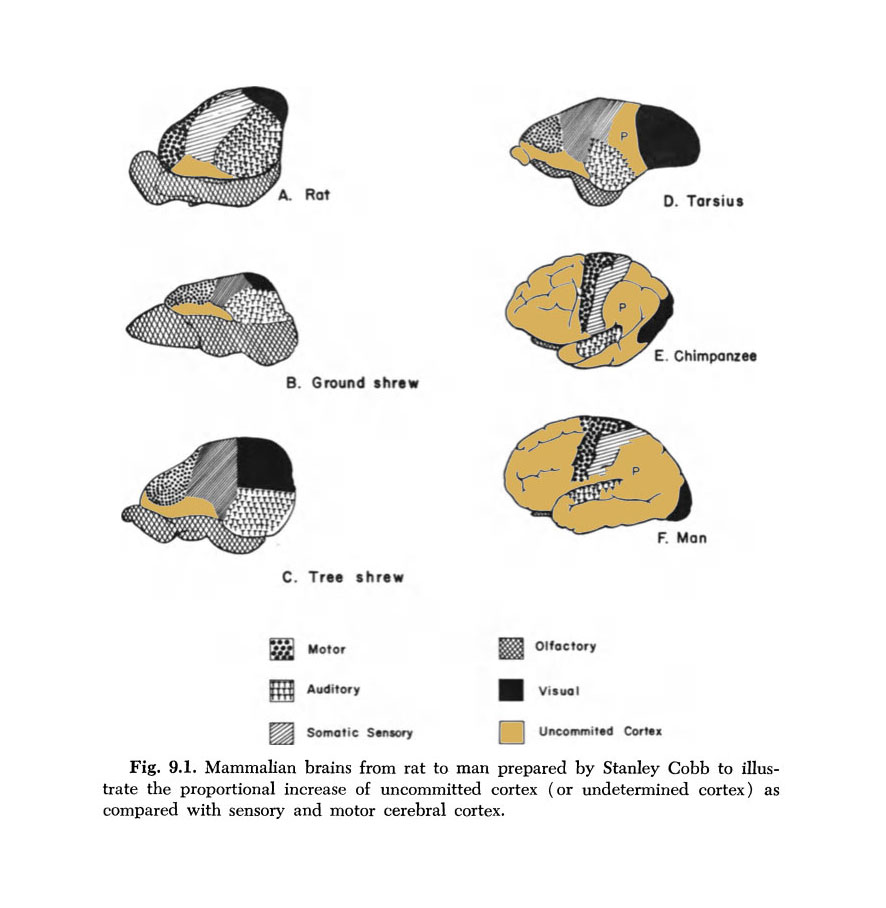
”"Man's brain is remarkable among mammals because of the greatly increased volume of the cerebral cortex...Unlike the cortex of the rat, which is completely motor or sensory except for a small undefined area, most of the human cortex is neither sensory in function nor motor... Man is different from lower mammals...[he is] part of an evolving society. He has in his brain, extensive areas of undefined and uncommitted cerebral cortex... The brain of man is molded by his mind."
Wilder Penfield (1966)
The human brain is not only larger than that of other mammals relative to body size, but the brain's cortex has evolved to be "un-committed" to sensory input, and instead is devoted to its "integrative capacity."[14]Speech, Perception and the Uncommitted Cortex by Wilder Penfield, Brain and Conscious Experience, Eccles 1966
Thus, Giurgea said, by understanding the evolutionary, structural, and functional arguments of the role played by the telencephalon in higher mammals, "it then becomes conceivable that one could pharmacologically intervene in a direct, specific manner upon the integrative efficiency of the telencephalon. And from that perspective, he put forward the nootropic concept.
Towards the Mind
Integrative Activity of the Mind
Giurgea defined integrative activity as: "the body of operations through which the brain accomplishes its most specific function, i.e., enables us to acquire new experiences, to retrieve past ones, and by a constant interaction between them, interfere with our own past and future."[15]Piracetam: Nootropic Pharmacology of Neurointegrative Activity, Giurgea 1976, P224
Through our sensory abilities, we create a "phantom-like" image of the real world. And then from complex, "integrating activity" in the telencephalon, we then derive our "capacities [of] perception, conscience, and other features of the inner life of a human being."
While other classifications include molecules that can have an effect on higher mental function, it is usually through an indirect pathway and is typically accompanied by side effects (especially in high doses). No other class includes agents that act directly on higher-level integrative activity or met the other properties and so it became clear that piracetam was the forerunner of an entirely new class.
Based on the evidence of a direct, selective activity of piracetam on the higher integrative mechanisms of the brain, in 1972, Giugea proposed the formation of an entirely new class of agents that would be known as nootropics, meaning "towards the mind."
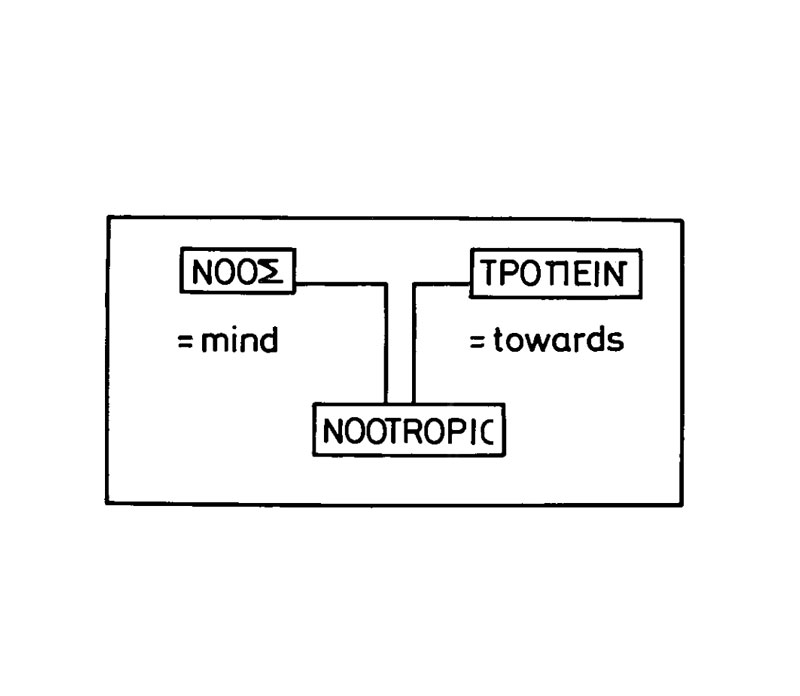
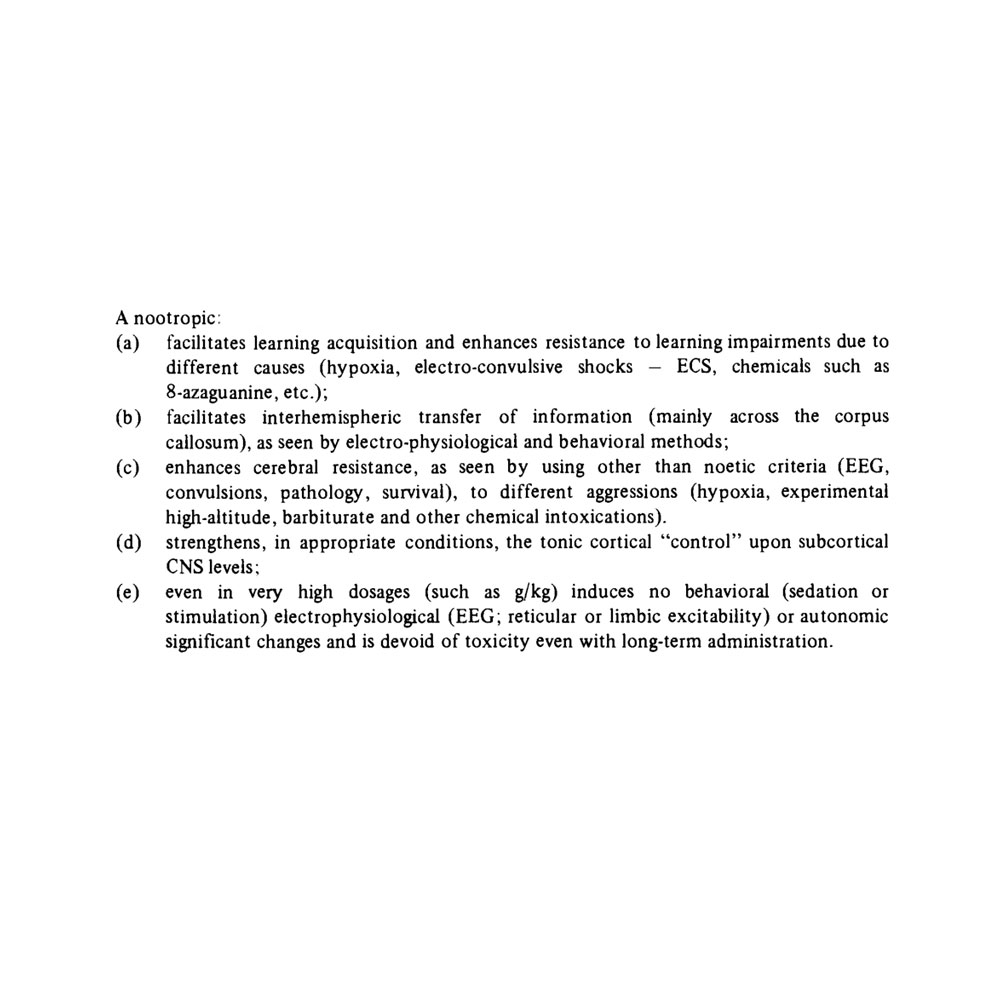
Pharmacology of Higher Brain Integrative Activity
Nootropic Classification
The prototypical nootropic agent:
(a) Facilitates learning acquisition and enhances resistance to learning impairments
(b) Facilitates interhemispheric transfer of information
(c) Enhances cerebral resistance to aggressions
(d) Strengthens control on subcortical CNS activity
(e) Virtually free of side effects and non-toxic even in very high doses
Nootropics are practically nontoxic and bear a direct impact on noetic, telencephalic, higher integrative mechanisms.
And like Michalenago, Giurgea had removed enough of the "excess of misunderstanding" to reveal the true beauty of the nootropic approach towards the integrative activity of the mind.[16]"Within the marble itself, Michelangelo thought lies the beauty, it is not created by the sculptor. He only takes out the excess of stone and so makes beauty available to our eyes. Scientific … Continue reading)
Increase In Interhemispherical Transmission
"Superconnection of the Brain"
Now that scientists had a framework for understanding the action of piracetam, they began devising new studies to explore how increases in efficiency of high-level activity could be demonstrated in healthy humans. In 1975 a study was devised to test the transfer of information across the corpus callosum in healthy college students.
Researchers administered a dichotic listening test, where words are played simultaneously on stereo headphones (with one message in the right ear and another message in the left ear), and subjects would be asked to write down as many words as they could remember from each ear.
Because words that come in the left ear are processed in the right side of the brain, then sent to the language area on the left side, they must cross the corpus callosum. This study showed remarkable results, the students on piracetam showed a 15% increase in their verbal capacity.
The scientists referred to this as a "superconnection of the brain," and stated: "what does seem to be established...is that there is an increase in the capacity for learning and the registration of verbal information is increased...It is tempting, however, to believe that superconnection not only leads to increased registration but also plays a part in integrating different brain areas and thus lead to a greater capacity for learning."
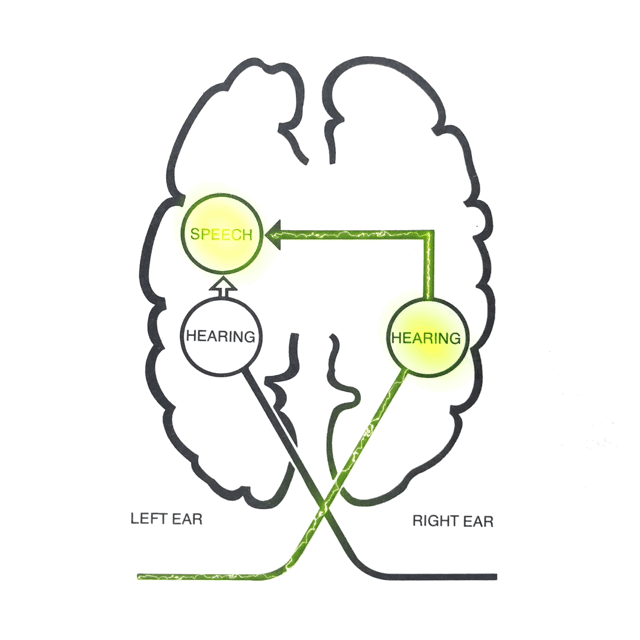
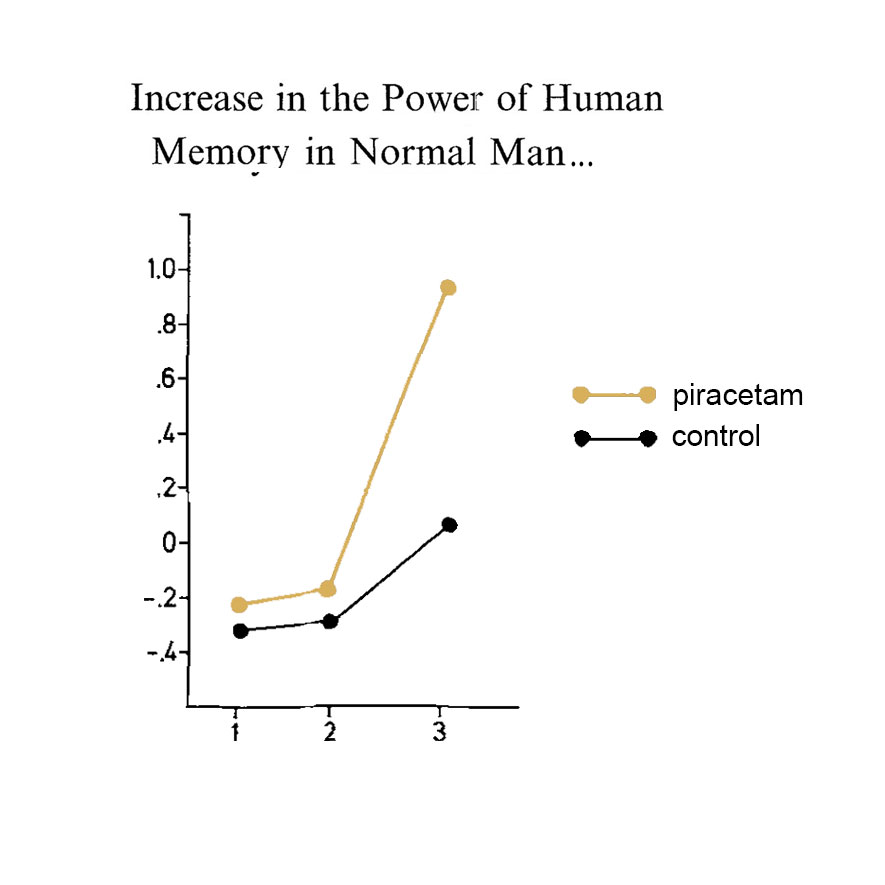
Enhancing the Healthy
"Increase In the Power of Human Memory"
As a follow up to the "superconnection" study, the researchers[17]Dimond and Brouwers set up another placebo-controlled, double-blind study on healthy college students. Instead of verbal learning though, they decided to test recall with written words.
In the study, subjects were shown two-syllable long words and were asked to recall them after varying lengths of time. After 14 days of treatment with piracetam, they found that both direct and delayed recall was significantly increased.
The researchers concluded that "piracetam promotes verbal learning and in this, it would appear to be a substance which in a specific respect is capable of extending the intellectual functions of man."
The researchers concluded that even though verbal learning is only one aspect of the intellect, this study demonstrated that "human brain power can be selectively increased." [18]"Increase in the power of human memory...", Dimond and Brouwers 1976
Synergistic Effects
Profound Effects Combining Piracetam Choline
Researchers studying deficient brains in older populations are constantly working to activate the cholinergic system, as the neurotransmitter acetylcholine is directly implicated in memory. Normally, administering choline alone can increase cholinergic transmission and raise the levels of acetylcholine in the brain.
However, in some older patients, their cholinergic systems are so deteriorated, that they are unable to turn the choline into acetylcholine. The scientists theorized that if they could administer choline, while simultaneously administering a compound that could correct for the critical age-related neuronal deficiencies, it might enable the choline to be properly metabolized.
When they learned that piracetam enables the central nervous system to function more effectively, the researchers[19]Profound effects of combining choline and piracetam on memory enhancement and cholinergic function in aged rats.
Bartus RT, Dean RL 3rd, Sherman KA, Friedman E, Beer B. decided to run an experiment on aged rats. They administered choline, piracetam, alone as well as the combination of the two.
Both choline and piracetam alone seemed to have a somewhat positive, albeit limited effect. However, when they combined piracetam and choline, the results were considered "profound." See the dramatic difference the combination makes in the gold bar labeled "C+P" in the accompanying graph.
Our Gold & Silver stacks are based on the principles behind this synergistic combination of ingredients.

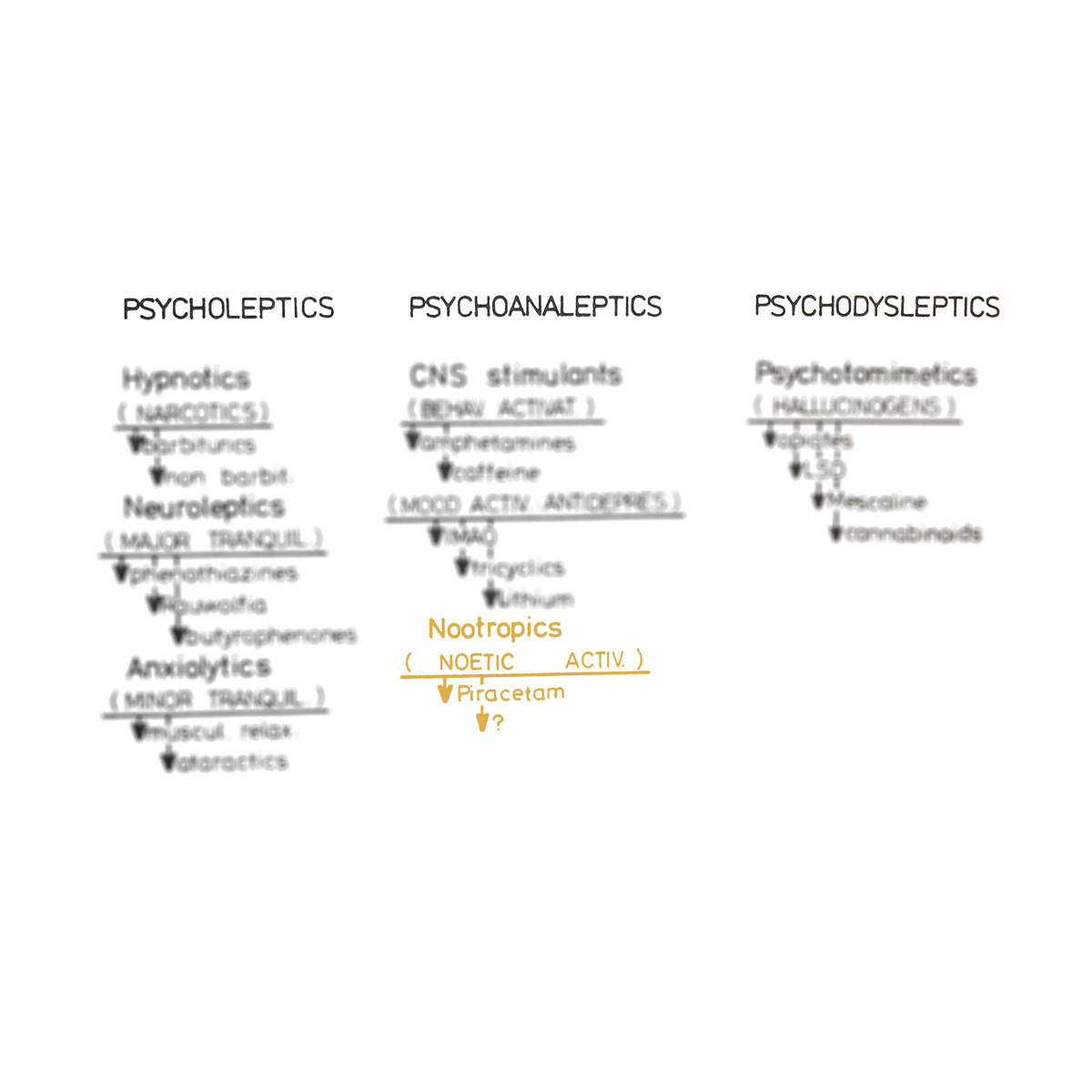
Quo Vadis
What is Next?
Having firmly established the nootropic concept, by the early 1980s Giurgea began to imagine the development of more advanced nootropic molecules.
He wrote, "I do consider piracetam merely as the first"[20]Fundamentals to a Pharmacology of the Mind, Chapter 9 of the nootropics and that "new nootropics should be made available, these should be more active than piracetam in terms of dosage, delay of therapeutic effect, duration of activity, etc."[21]Piracetam: Nootropic Pharamcology of Neurointegrative Activity, P264 He also thought that there should be versions that have a more specific effect on a given aspect of the nootropic concept.
Giurgea was not sure exactly what would come next though, which is which is why he left a "?" after Piracetam on the accompanying image showing where the nootropics classification fits.
That question mark now has an answer, because more advanced versions of piracetam have been successfully developed.
More Advanced
Next-Generation Nootropics
In the 1980s, labs began synthesizing new, more powerful versions of piracetam. Most of the time they kept the core structure of piracetam (the proline molecule) and made other modifications. You can see in the accompanying image, some of the variations that have been discovered.
Of those, Phenylpiracetam and Noopept, while very different from each other, stand out as the most promising versions to fulfill Giurgea's vision of a next-generation nootropic. Both were fully developed all the way through successful clinical trials in humans.
We have selected noopept for our Gold Formula, and phenylpiracetam for our Silver Formula.
Noopept was designed as a peptide version of piracetam that would be significantly more powerful and orally bioavailable, and by chance, it had anxiolytic properties.
Phenylpiracetam was designed to retain the cognitive enhancing aspects of piracetam, while also working to enhance endurance and processing speed.
These are the nootropics selected for use in our formula due to the wide body of research on both, including decades of clinical use with demonstrated and well-known pharmacokinetics. They are also consistently the top recommended compounds among biohackers in the nootropics community.

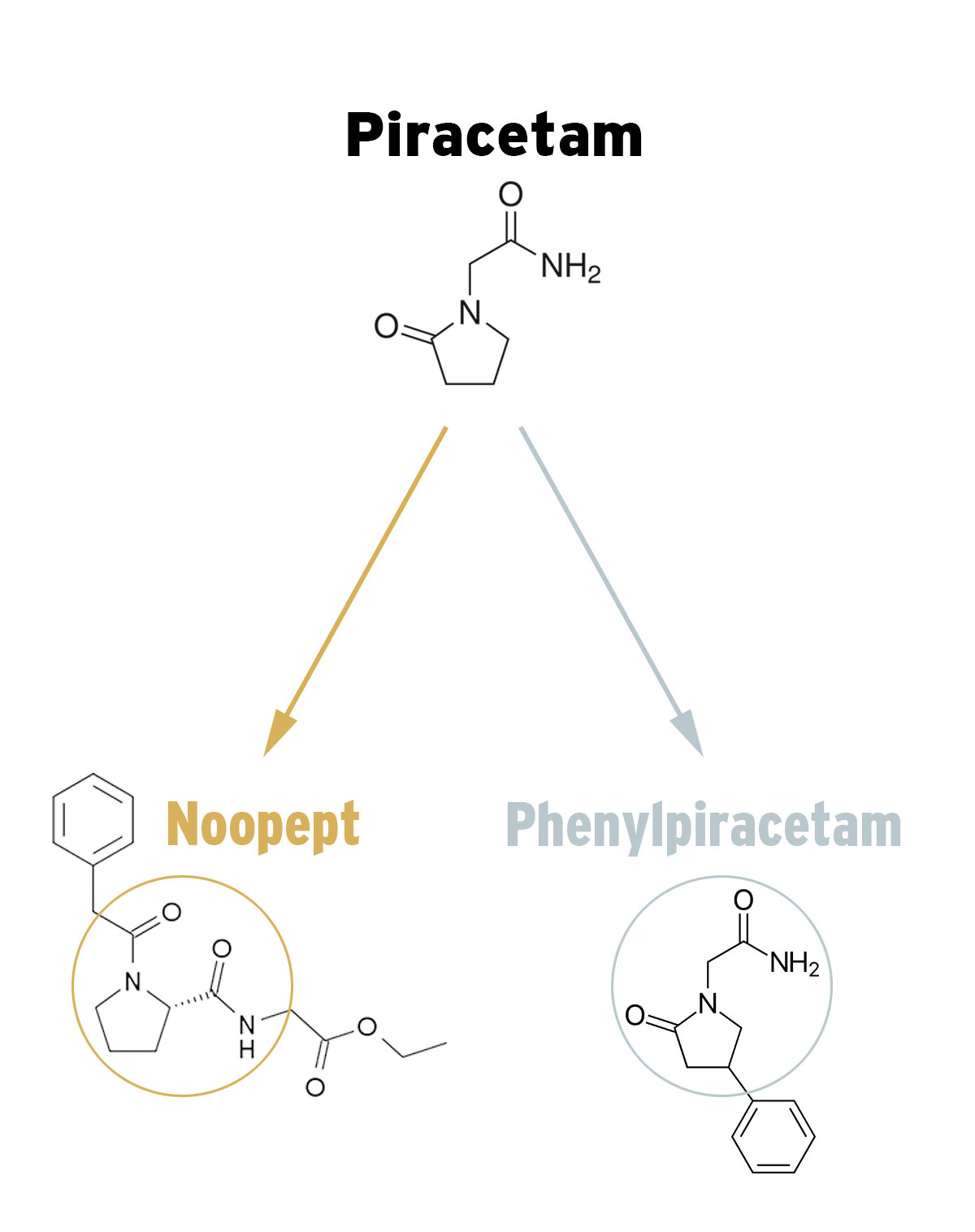
Noopept
Noopept was developed to be a more bioavailable version of the original nootropic piracetam based on a neuropeptide. Researchers succeeded beyond their expectations and created a molecule significantly more potent by molecular weight, which also has more pronounced neuroprotective and memory restoring properties.[22]Ostrovskaya RU, Romanova GA, Barskov IV, Shanina EV, Gudasheva TA, Victorov IV, Voronina TA, Seredenin SB (1999). “Memory restoring and neuroprotective effects of the proline-containing … Continue reading. In studies on the Alzheimer’s disease model, Noopept has restored spatial memory and increased immunoreactivity to amyloid buildup. [23]Ostrovskaya RU, Gruden MA, Bobkova NA, Sewell RD, Gudasheva TA, Samokhin AN, Seredinin SB, Noppe W, Sherstnev VV, Morozova-Roche LA (2007). “The nootropic and neuroprotective proline-containing … Continue reading Studies also show Noopept to stimulate the expression of Nerve Growth Factor (NGF) and Brain-Derived Neurotropic Factor (BDNF) in the hippocampus and cerebral cortex. BDNF is a protein that is crucial in determining the quantity of new neurons the brain can create, as well as regulating growth, survival and, differentiation of existing neurons.[24]” We showed that the nootropic drug increases expression of neurotrophic factors in the hippocampus. Our results are consistent with the hypothesis that neurotrophin synthesis in the … Continue reading
Phenylpiracetam
Phenylpiracetam is a nootropic substance that was developed in Russia in 1983 and is chemically related to Piracetam, but considered 30-60 times stronger. A single dose of phenylpiracetam has been shown to cause a “significant increase in locomotor activity” and a “significantly enhanced memory function” in a passive avoidance test.[25]Zvejniece L, <em>et al</em>. <a href=”http://www.ncbi.nlm.nih.gov/pubmed/21689376″ target=”_new” rel=”nofollow”>Investigation into … Continue reading. It has also been shown to “increase physical endurance” and “resistance to cold”[26] “Carphedon is a phenyl derivative of nootropil and is effective in increasing physical endurance and cold resistance, and is used for amnesia treatment.” Analyst. 1999 … Continue reading. It has been shown to increase cognitition in persons with cognitive decline from organic causes.[27]Lybzikova GN, Iaglova ZhS, Kharlamova IuS. The efficacy of phenotropil in the complex treatment of epilepsy. Zh Nevrol Psikhiatr Im S S Korsakova. (2008) It has also been shown to improve cognition in youth with epilepsy. In rodent trials Phenylpiracetam has been shown to improve retention latency by over 185%. [28]Zvejniece L, et al. Investigation into stereoselective pharmacological activity of phenotropil. Basic Clin Pharmacol Toxicol.
Formulas & Ingredients
We have combined over 50 years of research on nootropics with cutting-edge neuroscience and insights from the worlds leading biohackers to develop the Nootroo Gold & Silver Formulas.
A 30-count bottle of Nootroo Gold & Silver contains 15 capsules of the Gold Formula and 15 capsules of the Silver Formula.
The Gold formula contains Noopept and Citicoline and the Silver Formula contains Phenylpiracetam and Citicoline.
The Formulas are designed to be alternated between daily.
Gold & Silver Formulas

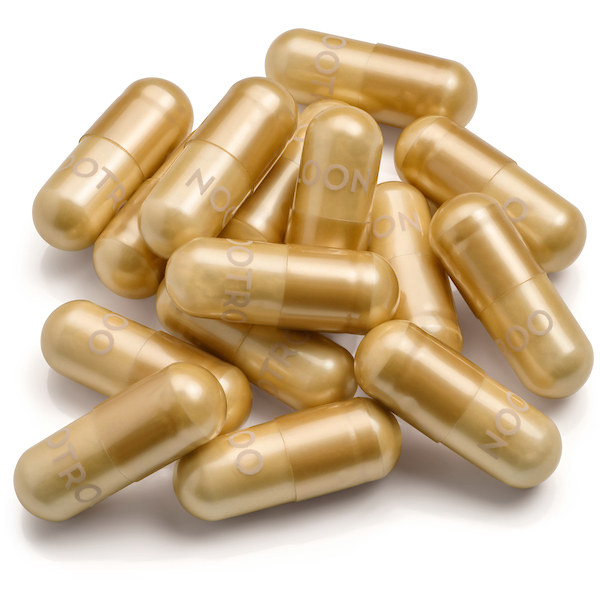
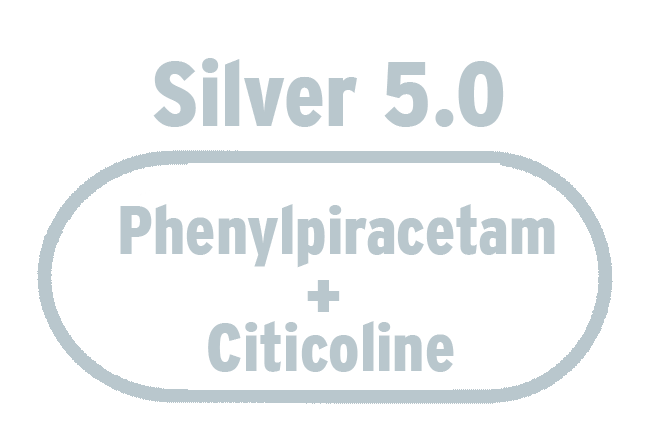


Noopept
Noopept was developed to be a more bioavailable version of the original nootropic piracetam based on a neuropeptide. Researchers succeeded beyond their expectations and created a molecule significantly more potent by molecular weight, which also has more pronounced neuroprotective and memory restoring properties.[29]Ostrovskaya RU, Romanova GA, Barskov IV, Shanina EV, Gudasheva TA, Victorov IV, Voronina TA, Seredenin SB (1999). “Memory restoring and neuroprotective effects of the proline-containing … Continue reading. In studies on the Alzheimer’s disease model, Noopept has restored spatial memory and increased immunoreactivity to amyloid buildup. [30]Ostrovskaya RU, Gruden MA, Bobkova NA, Sewell RD, Gudasheva TA, Samokhin AN, Seredinin SB, Noppe W, Sherstnev VV, Morozova-Roche LA (2007). “The nootropic and neuroprotective proline-containing … Continue reading Studies also show Noopept to stimulate the expression of Nerve Growth Factor (NGF) and Brain-Derived Neurotropic Factor (BDNF) in the hippocampus and cerebral cortex. BDNF is a protein that is crucial in determining the quantity of new neurons the brain can create, as well as regulating growth, survival and, differentiation of existing neurons.[31]” We showed that the nootropic drug increases expression of neurotrophic factors in the hippocampus. Our results are consistent with the hypothesis that neurotrophin synthesis in the … Continue reading

Phenylpiracetam
Phenylpiracetam is a nootropic substance that was developed in Russia in 1983 and is chemically related to Piracetam, but considered 30-60 times stronger. A single dose of phenylpiracetam has been shown to cause a “significant increase in locomotor activity” and a “significantly enhanced memory function” in a passive avoidance test.[32]Zvejniece L, <em>et al</em>. <a href=”http://www.ncbi.nlm.nih.gov/pubmed/21689376″ target=”_new” rel=”nofollow”>Investigation into … Continue reading. It has also been shown to “increase physical endurance” and “resistance to cold”[33] “Carphedon is a phenyl derivative of nootropil and is effective in increasing physical endurance and cold resistance, and is used for amnesia treatment.” Analyst. 1999 … Continue reading. It has been shown to increase cognitition in persons with cognitive decline from organic causes.[34]Lybzikova GN, Iaglova ZhS, Kharlamova IuS. The efficacy of phenotropil in the complex treatment of epilepsy. Zh Nevrol Psikhiatr Im S S Korsakova. (2008) It has also been shown to improve cognition in youth with epilepsy. In rodent trials Phenylpiracetam has been shown to improve retention latency by over 185%. [35]Zvejniece L, et al. Investigation into stereoselective pharmacological activity of phenotropil. Basic Clin Pharmacol Toxicol.
In Both Formulas:
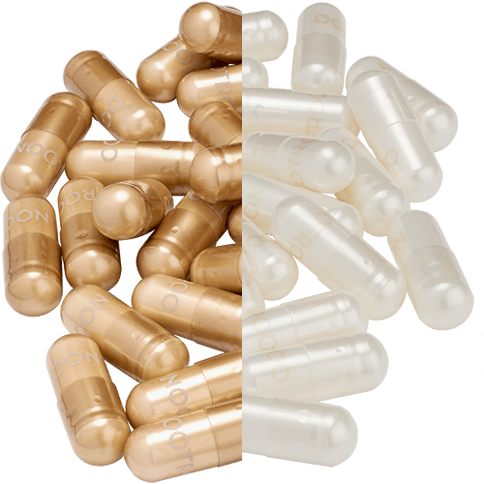

Citicoline
Citicoline is a precursor for the memory neurotransmitter acetylcholine, and supplementation has been shown to increase acetylcholine production in the brain. Citicoline administration has also been shown to increase brain bioenergetics by increasing energy reserves and utilization of energy. It’s administration also increases the amount of essential phospholipid membrane components needed to synthesize and maintain cell membranes[36]Citicoline enhances frontal lobe bioenergetics as measured by phosphorus magnetic resonance spectroscopy.. Studies in healthy women show that taking Cognizin citicoline significantly improved their verbal memory after just 28 days[37]Improved Attentional Performance Following Citicoline Administration in Healthy Adult Women Studies suggest that citicoline also can help increase dopamine receptor densities [38]Giménez R, Raïch J, Aguilar J (November 1991).”Changes in brain striatum dopamine and acetylcholine receptors induced by chronic CDP-Choline treatment of aging mice”. British Journal … Continue reading, which is the neurotransmitter associated with motivation. Cognizin is a patented form of Citicoline that is created in a bioreactor process that takes 6 months and yields the only pure, free-base form of citicoline that is bioidentical to the form found in nature.

Monthly SubscriptionMost Popular
$ 99
Per Month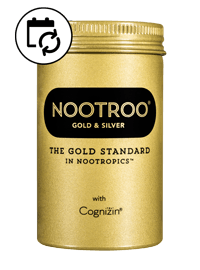
- 30 Day Supply
- 15 Gold Formula & 15 Silver Formula
- Never Run Out of Supply
- Discounted Price For Long Term Results
- $49.95
30-Day Supply
$ 99
Per Month
- 30 Day Supply
- 15 Gold Formual & 15 Silver Formula
- 30 Day Access to the Nootroo Protocol
- $59.95
References
| ↑1 | How To Deal With An Unusual Pharmacological Pattern: The Nootropic Case, C Giurgea, P197, 1976 |
|---|---|
| ↑2 | "Within the marble itself, Michelangelo thought lies the beauty, it is not created by the sculptor. He only takes out the excess of stone and so makes beauty available to our eyes. Scientific creativity often resembles this process...He only removes the excess of misunderstanding...That was the case with our nootropic research which we now consider as one potential approach to the pharmacology of the integrative activity of the brain." Corneliu Giurgea (1981) |
| ↑3 | "Piracetam was such a challenge to our laboratory until we accumulated an important body of knowledge, which made it possible to attempt a relatively comprehensive interpretation of the particular and complex pharmacology of [it]" Giugea, Fundamentals to a Pharmacology of the Mind p191 |
| ↑4 | "Piracetam: Nootropic Pharmacology of the Neurointegrative Activity, P229 |
| ↑5 | Giurgea et al 1976 |
| ↑6 | at their lab, UCB Pharma in Belgium |
| ↑7 | Fundamentals to a Pharmacology of the Mind, Giugea 1981 |
| ↑8 | Personal Communications between Giurgea and Prof. Hilboom and Dr. Jahro |
| ↑9 | How To Deal With An Unusual Pharmacological Pattern ; The Nootropic Case, C Giurgea, P198, 1976 |
| ↑10 | Personal Communications between Giurgea and Prof. Sorel |
| ↑11 | Personal Communications between Giurgea and Prof. Ectors in Bruxelles |
| ↑12 | How to Deal With an Unusual Pharmacological Pattern: The Nootropic Case, Giurgea 1976, P198 |
| ↑13 | Fundamentals to a Pharmacology of the Mind, Giurgea 1981 P 192 |
| ↑14 | Speech, Perception and the Uncommitted Cortex by Wilder Penfield, Brain and Conscious Experience, Eccles 1966 |
| ↑15 | Piracetam: Nootropic Pharmacology of Neurointegrative Activity, Giurgea 1976, P224 |
| ↑16 | "Within the marble itself, Michelangelo thought lies the beauty, it is not created by the sculptor. He only takes out the excess of stone and so makes beauty available to our eyes. Scientific creativity often resembles this process...He only removes the excess of misunderstanding...That was the case with our nootropic research which we now consider as one potential approach to the pharmacology of the integrative activity of the brain." Corneliu Giurgea (1981 |
| ↑17 | Dimond and Brouwers |
| ↑18 | "Increase in the power of human memory...", Dimond and Brouwers 1976 |
| ↑19 | Profound effects of combining choline and piracetam on memory enhancement and cholinergic function in aged rats. Bartus RT, Dean RL 3rd, Sherman KA, Friedman E, Beer B. |
| ↑20 | Fundamentals to a Pharmacology of the Mind, Chapter 9 |
| ↑21 | Piracetam: Nootropic Pharamcology of Neurointegrative Activity, P264 |
| ↑22, ↑29 | Ostrovskaya RU, Romanova GA, Barskov IV, Shanina EV, Gudasheva TA, Victorov IV, Voronina TA, Seredenin SB (1999). “Memory restoring and neuroprotective effects of the proline-containing dipeptide, GVS-111, in a photochemical stroke model”. Behavioural Pharmacology 10 (5): 549–553 |
| ↑23, ↑30 | Ostrovskaya RU, Gruden MA, Bobkova NA, Sewell RD, Gudasheva TA, Samokhin AN, Seredinin SB, Noppe W, Sherstnev VV, Morozova-Roche LA (2007). “The nootropic and neuroprotective proline-containing dipeptide noopept restores spatial memory and increases immunoreactivity to amyloid in an Alzheimer’s disease model”. Journal of Psychopharmacology 21 (6): 611–619. |
| ↑24, ↑31 | ” We showed that the nootropic drug increases expression of neurotrophic factors in the hippocampus. Our results are consistent with the hypothesis that neurotrophin synthesis in the hippocampus determines cognitive function, particularly in consolidation and delayed memory retrieval. Published data show that neurotrophic factor deficiency in the hippocampus is observed not only in advanced Alzheimer’s disease, but also at the stage of mild cognitive impairment (predisease state). In light of this, our findings suggest that Noopept holds much promise to prevent the development of Alzheimer’s disease in patients with mild cognitive impairment. Moreover, therapeutic effectiveness of Noopept should be evaluated at the initial stage of Alzheimer’s disease.” |
| ↑25, ↑32 | Zvejniece L, <em>et al</em>. <a href=”http://www.ncbi.nlm.nih.gov/pubmed/21689376″ target=”_new” rel=”nofollow”>Investigation into stereoselective pharmacological activity of phenotropil</a>. <em>Basic Clin Pharmacol Toxicol</em>. 2011 |
| ↑26, ↑33 | “Carphedon is a phenyl derivative of nootropil and is effective in increasing physical endurance and cold resistance, and is used for amnesia treatment.” Analyst. 1999 Nov;124(11):1559-62. <a href=”http://www.ncbi.nlm.nih.gov/pubmed/10746314″>PMID: 10746314</a> |
| ↑27, ↑34 | Lybzikova GN, Iaglova ZhS, Kharlamova IuS. The efficacy of phenotropil in the complex treatment of epilepsy. Zh Nevrol Psikhiatr Im S S Korsakova. (2008) |
| ↑28, ↑35 | Zvejniece L, et al. Investigation into stereoselective pharmacological activity of phenotropil. Basic Clin Pharmacol Toxicol. |
| ↑36 | Citicoline enhances frontal lobe bioenergetics as measured by phosphorus magnetic resonance spectroscopy. |
| ↑37 | Improved Attentional Performance Following Citicoline Administration in Healthy Adult Women |
| ↑38 | Giménez R, Raïch J, Aguilar J (November 1991).”Changes in brain striatum dopamine and acetylcholine receptors induced by chronic CDP-Choline treatment of aging mice”. British Journal of Pharmacology 104(3): 575–8. |



